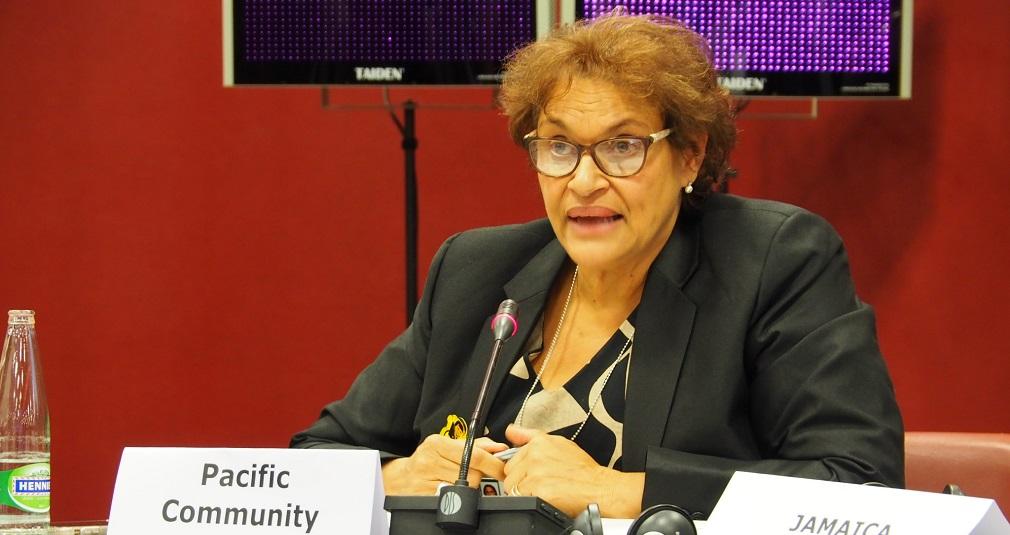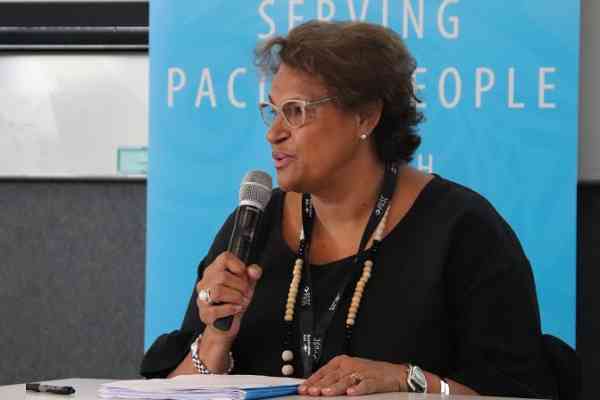Check against delivery
Global Platform for Disaster Risk Reduction
Statement by Dr Audrey Aumua
Deputy Director General, The Pacific Community (SPC)
Your Excellency, the Secretary General of the United Nations
Honourable Presidents and Prime Ministers of States,
Your Excellencies the Heads of Delegations,
Distinguished Delegates,
Ladies and Gentlemen.
The Pacific Community (SPC) is grateful for the opportunity to present a statement to the Global Platform for Disaster Risk Reduction. As the intergovernmental organisation with the mandate to lead and coordinate disaster risk management capacity building in the Pacific, we present this statement on behalf of our sister regional organisations, development partners and members of the Pacific Resilience Partnership.
From 01-03 May this year, the Pacific Resilience Partnership came together for the Inaugural Pacific Resilience Meeting. The theme: “Youth Futures in a Resilient Pacific’ recognised the critical role of youth as important stakeholders and actors in Pacific resilience. The event filled the venues of the University of the South Pacific, and saw inspiring and informative presentations, debates and interactive sessions from stakeholders from across the region. But most of all, it showed the passion and the absolute dedication that the Pacific has for taking collective and comprehensive action on creating a truly Resilient Pacific.
The Pacific Resilience Partnership is a relatively new mechanism established in 2017 to support Pacific counties in their efforts to strengthen resilience in connection with the Framework for Resilience Development in the Pacific: An Integrated Approach to Address Climate Change and Disaster Risk Management 2017 – 2030 (FRDP). As such, the Pacific Resilience Partnership is a network of interests and expertise that is key to the implementation of the Sendai Framework in the Pacific islands region.
The Pacific is often described as one of the world’s most vulnerable regions. The 2017 World Risk Report placed Vanuatu (#1), Tonga (#2), Solomon Islands and Fiji amongst the top 15 countries with the highest risk worldwide. However, I am pleased to report that these four countries, along with their Pacific neighbours, are at the forefront of a change process that integrates climate change and disaster risk management under the FRDP.
The FRDP provides high-level strategic guidance to different stakeholder groups on enhancing resilience to climate change and disasters, in ways that contribute to sustainable development. Smart development policy must be guided by climate and disaster risk assessments to ensure the best combinations of investments and resources are in place to prepare, prevent or mitigate risks. As we have learned all to well, there is no silver bullet for addressing disaster and climate vulnerabilities.
We recognise that resilient development requires the collective and concerted actions of National Governments, civil society, private sector, regional organisations, community practitioners and development partners. The FRDP offers a vehicle through which all stakeholders can help implement international frameworks including: the Sendai Framework for Disaster Risk Reduction; the Paris Agreement on Climate Change; and the Agenda 2030 for Sustainable Development.
The Pacific Community’s contributions to the efforts of the Pacific Resilience Partnership and in progressing implementation of the FRDP, lie in our position as the principal scientific and technical organisation in the Pacific region. Using applied science and technology we respond to Pacific Island national development priorities across a number of areas - food security, water security, education, public health, human rights and disaster and climate resilience, This includes the collection and analysis of risk information to support evidence-based decisions and actions. If I may add that resilience building is not just about managing the risks posed by large catastrophic events, the cumulative impacts of smaller, more frequent events are just as important to address.
Other regional organisations like the Pacific Islands Forum Secretariat, which convene and coordinate political level discourse on resilience action and also specifically risk governance and financing; the Secretariat of the Pacific Regional Environment Programme which coordinates action on climate change; the University of the South Pacific which helps to galvanise the support of academia for resilience building; representatives from civil society, the private sector, multilateral development banks, donors and of course the UN family, coalesce regularly under the umbrella of the Pacific Resilience Partnership in support of our Pacific island countries.
The Pacific Resilience Partnership and the FRDP are prime examples of how Pacific regionalism can support and complement national plans and transboundary challenges. The achievement of the 2030 Agenda for Sustainable Development, or the Sendai Framework requires more than the sum of national actions: it calls for collective efforts to tackle regional and global issues. The spirit of this is captured in the vision of the Pacific Leaders for a Blue pacific “calling for a region of peace, harmony, security, social inclusion, and prosperity, so that all Pacific people can lead free, healthy, and productive lives”.
Through the concerted efforts of our Pacific Governments, Pacific intergovernmental organisations, civil society, private sector, community practitioners and development partners, we can collectively work towards building a safer and more resilient Pacific.
Chair, I thank you.



